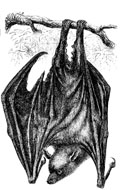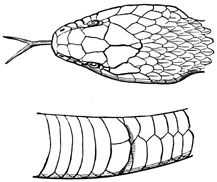May 2003
Nocturnal
Adaptations
This
month's spotlight is not specifically about any animal. Instead,
we have compiled some valuable information from one of Kit Sun's
lectures on the above topic. The lecture has helped us gain a better
understanding of nocturnal creatures and hence we wish to share
them with everyone.
The
following are the summaries of the main points taken during the
lecture. Let us look at the nocturnal adaptations of the
following 5 main groups of creatures:
1)
Bats
|
|
Mega-bats
i)
Excellent
sense of smell for location of food (fruit).
ii)
Good eyesight
to navigate in the dark.
iii)
Longer faces
- larger surface area to absorb molecules to interpret the
scent.
iv)
Can echolocate when it is too dark but their echolocation
is not as good as those of insect-eating bats.
|

E.g. flying
fox, dog-faced fruit bat
|
|
|
Micro-bats
|
i)
These
bats literally scream constantly throughout the night. They
can 'close' their ears while 'screaming' to prevent
resulting deafness and can open them again soon after to listen
for returning echos.
|

ii)
Their
mouths or flower-like
noses produce sonar signals to detect prey (e.g. insects).
The large ears can act as radar dishes to receive the echos.
|
|

iii)
They
have small eyes and are rather short-sighted but their
eyesight is still good enough to navigate. Can rely on echolocation
as a back-up tool if visibility is very poor.
|
|
iv)
Micro-bats
can modulate their call frequencies to detect moving
objects. If the insect is moving away, the bat increases the
frequency of its calls. If the insect is coming closer, the
bat will lower the frequency of its call. The resolutions
of the echos are also very good.
v)
Some
moths can 'absorb' the active sonars released by the bats
and subsequently use stealth to avoid detection. Certain
moths have even evolved to send back active sonars to the
bats, thus confusing their predators into thinking that the
moth is another bat. See Moth
Defense Systems.
|
|
|
2)
Owls
|
i)
Facial
disk that resembles a radar dish to direct sounds
into the ears.
|
 |
ii)
Binocular
vision like all predators. The eyes of owls are so large
that they cannot move them at all but to make for it, the
neck can turn up to 270 degrees!
|
|
iii)
Owls
can catch their prey in complete darkness just by using their
acute hearing.
|
|
iv)
For
some owls, one ear is higher than the other and hence one
ear can receive sounds faster than the other.
|
|
v)
When
an owl moves its head from side to side, it is trying to pinpoint
the exact source of a sound.
|


|
vi)
When
a sound is detected, the owl will turn its head and face directly
at the source of the sound. Once it determines the location
of the prey, the owls takes off and flies silently towards
it. Just before striking, the owl stretches its legs forward
until they are in a 'straight line' between its eyes and the
prey. This will confirm the final exact location of the prey
before the talons lash out and grasp. Split-seconds before
striking, the owl closes its eyes to protect them.
|
|
vii)
Most
nocturnal creatures that the owl preys on, e.g. mouse can
also hear extremely well so to keep one step ahead, the owl
has developed stealth. There are microscopic ridges
at the leading edges of the primary wing feathers to help
muffle out friction with the air (reduce normal turbulence
into micro-turbulence and eventually to silence). The prey
can smell the owls at very close range but by then, it is
too late.
|
|
|
|
3)
Reptiles (e.g. Pythons)
 i)
Good eyesight
that can see some color.
i)
Good eyesight
that can see some color.
ii)
Can also
smell well using their forked tongue. Pythons mainly use
smell to detect their prey.
iii)
They switch
to infra-red when the prey is within closer range. Pythons
have heat sensing pits along their upper lips for detecting warm-blooded
prey (pit vipers have them too).
iv)
Pythons tend
to be active after rainfall, especially on nights after afternoon
showers. The rain would have cooled the soil and this means that
warm-blooded prey are relatively easier to detect.
4)
Cats
 i)
Sight -
Cats have good eyesight and see in monochrome. Their eyes contain
both rods and some cones and hence they also possess limited color
vision.
i)
Sight -
Cats have good eyesight and see in monochrome. Their eyes contain
both rods and some cones and hence they also possess limited color
vision.
ii)
Hearing
- In low light, cats rely on their excellent hearing. Their ears
are set far apart and can swivel forward to increase baseline of
incoming sounds. They can also turn their heads and face the sound
to hear better.
iii)
Whiskers
of the cat are tools use for short range navigation (e.g. to avoid
knocking into objects). Facial muscles can help to 'move' the whiskers
for better navigation.
iv)
Smell
- Their sense
of smell is not as good as those of dogs because of their flatter
muzzles/faces. However, cats can recognise a variety of smells,
especially those of other cats. Hence they often use urine to scent
mark their territories.
v)
Stealth -
Cats have soft touch pads beneath their paws so that they can move
as silently as possible without alarming their prey.
5) Dogs
 i)
Smell
- This is the most crucial sense of a dog and a large part of their
brains is devoted to just interpret smells. The nose is wet all
the time because water is a good solvent for molecules to get sucked
into the nasal passage. Hence, dogs often lick their noses to keep
them moist. The dog's nose is very sensitive and if they get hit
on the nose, it can be very dreadful for the dog.
i)
Smell
- This is the most crucial sense of a dog and a large part of their
brains is devoted to just interpret smells. The nose is wet all
the time because water is a good solvent for molecules to get sucked
into the nasal passage. Hence, dogs often lick their noses to keep
them moist. The dog's nose is very sensitive and if they get hit
on the nose, it can be very dreadful for the dog.
The
dog's sense of smell is so keen that drug dogs have been known to
detect heroine hidden among gasoline.
Dogs
also have infra-red in their nose that can detect cancer growth
in humans.
ii)
Hearing
- though not as good as cats but definitely better than humans and
they can even detect low frequency sounds.
iii)
Sight
- Dogs are a little short-sighted and they see in monochrome.
iv)
Whiskers
- same as in cats.
Extra notes
on Dogs:
Dog
Behaviour - Only the dominant male dog in the pack can urinate
with its hind leg lifted up. All other subordinate males must urinate
in squatting posture like female dogs. A sub male that attempts
to urinate with its hind leg up is issuing a challenge to the dominant
dog for the leadership position.
Only
the dominant dog of the pack moves around with its tail up. All
other members must keep their tails down or face the wrath of the
leader.
Acknowledgements
- Facts of the
above were purely taken down during Kit Sun's lecture of "Nocturnal
Adaptations" on 25 May 2003. Pictures
from an Animal Drawings CD-Rom.
Back to
Animal
Spotlight
Home
| Explore
| Rangers’ Station
| Walking Trails
| Tram Ride
| Resources
|
©
2009 NSRangers.Tripod.com. All rights reserved.
|








 i)
Good eyesight
that can see some color.
i)
Good eyesight
that can see some color. i)
Sight -
Cats have good eyesight and see in monochrome. Their eyes contain
both rods and some cones and hence they also possess limited color
vision.
i)
Sight -
Cats have good eyesight and see in monochrome. Their eyes contain
both rods and some cones and hence they also possess limited color
vision. i)
Smell
- This is the most crucial sense of a dog and a large part of their
brains is devoted to just interpret smells. The nose is wet all
the time because water is a good solvent for molecules to get sucked
into the nasal passage. Hence, dogs often lick their noses to keep
them moist. The dog's nose is very sensitive and if they get hit
on the nose, it can be very dreadful for the dog.
i)
Smell
- This is the most crucial sense of a dog and a large part of their
brains is devoted to just interpret smells. The nose is wet all
the time because water is a good solvent for molecules to get sucked
into the nasal passage. Hence, dogs often lick their noses to keep
them moist. The dog's nose is very sensitive and if they get hit
on the nose, it can be very dreadful for the dog.